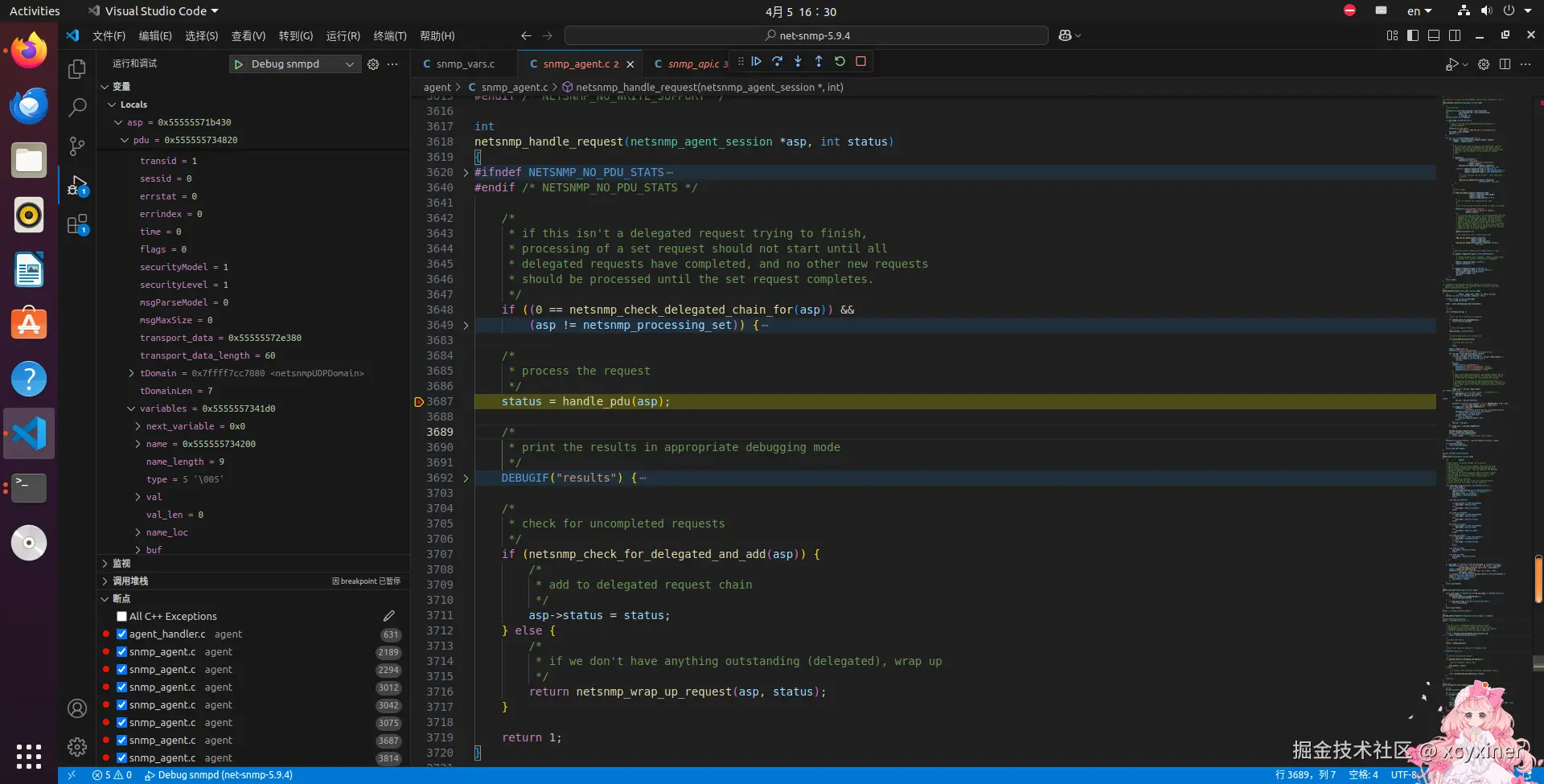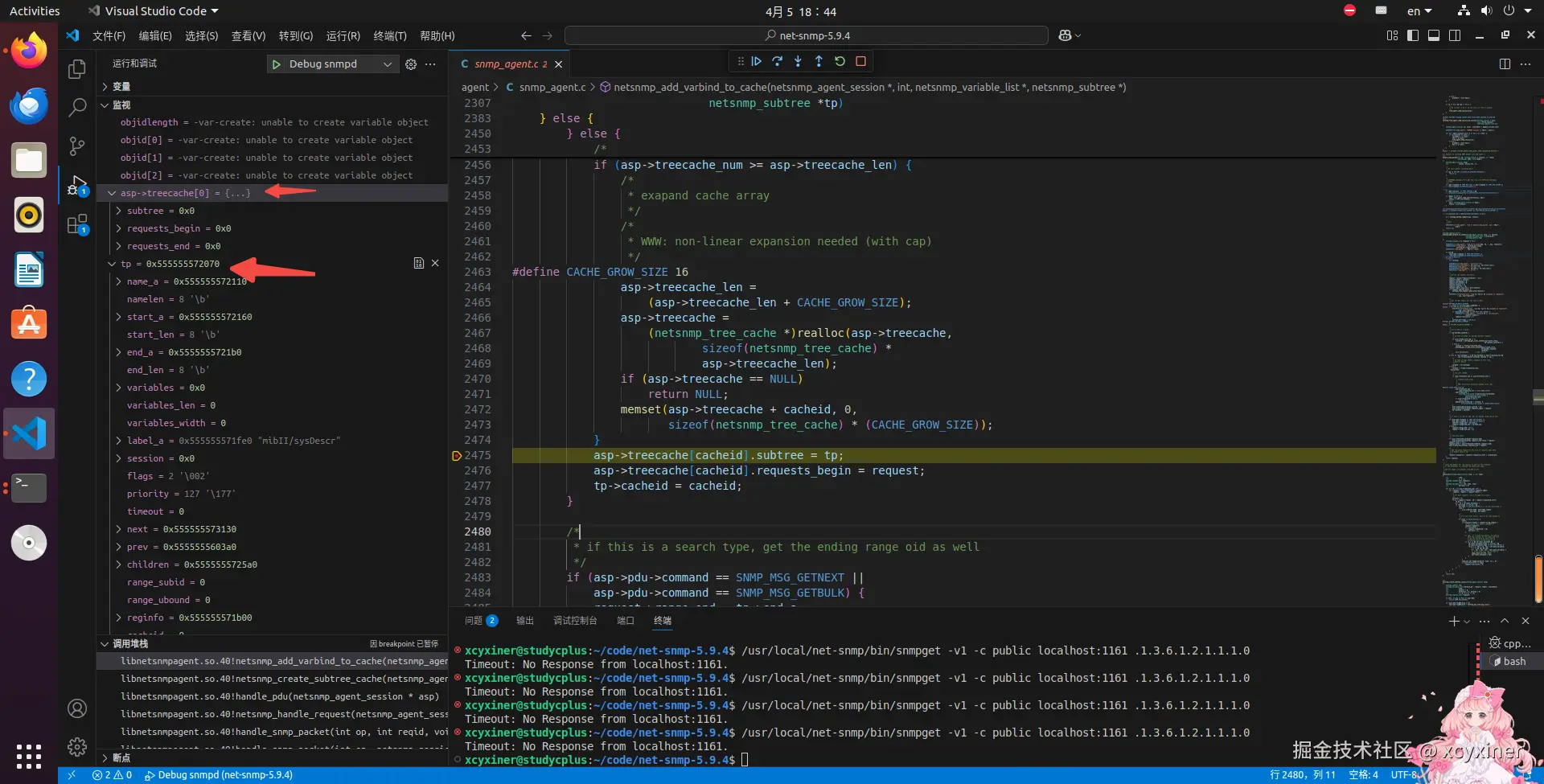1背景
这一篇是snmp v1 get请求优化(中) 的后续部分,上一篇计划找oid怎么设置的,但是只找了请求部分的解析,没找到怎么赋值的。这一篇继续寻找。
2分析net-snmp源码
上一篇 2.1.1 断点,调试,模拟GET请求 定位到了handle_snmp_packet,是继续堆栈 往前找的,这里往后找。
2.1起始界面如下所示

相关的代码如下
c++
/** handles an incoming SNMP packet into the agent */
int
handle_snmp_packet(int op, netsnmp_session * session, int reqid,
netsnmp_pdu *pdu, void *magic)
{
netsnmp_agent_session *asp;
int status, access_ret, rc;
/*
* We only support receiving here.
*/
if (op != NETSNMP_CALLBACK_OP_RECEIVED_MESSAGE) {
return 1;
}
//这里打断点
rc = netsnmp_handle_request(asp, status);
/*
* done
*/
DEBUGMSGTL(("snmp_agent", "end of handle_snmp_packet, asp = %8p\n",
asp));
return rc;
}在netsnmp_handle_request 处打断点,直接运行到这里(之前的没有设置不看也行,比如下图,直接看asp下的pdu中的绑定的变量值,大小还是0)

2.2 netsnmp_handle_request 追踪
f11进入到该方法后,在handle_pdu处打断点。判断逻辑还是查看asp中pdu绑定的变量值。
c++
int
netsnmp_handle_request(netsnmp_agent_session *asp, int status)
{
/*
* process the request
*/
//这里打断点
status = handle_pdu(asp);
return 1;
}
f11进入到handle_pdu,再次追加断点
c++
int
handle_pdu(netsnmp_agent_session *asp)
{
/*
* get the results
*/
//这里打断点
status = handle_var_requests(asp);
2.3 handle_var_requests 追踪
f11进入到handle_var_requests,再次追加断点
c++
int
handle_var_requests(netsnmp_agent_session *asp)
{
/*
* now, have the subtrees in the cache go search for their results
*/
for (i = 0; i <= asp->treecache_num; i++) {
/*
* don't call handlers w/null reginfo.
* - when is this? sub agent disconnected while request processing?
* - should this case encompass more of this subroutine?
* - does check_request_status make send if handlers weren't called?
*/
if(NULL != asp->treecache[i].subtree->reginfo) {
reginfo = asp->treecache[i].subtree->reginfo;
//这里追加断点
status = netsnmp_call_handlers(reginfo, asp->reqinfo,
asp->treecache[i].requests_begin);
}
f11进入netsnmp_call_handlers后再次追加断点(这里就得看reqinfo里的asp下面的pdu下的变量绑定了)
c++
/** @private
* Calls all the MIB Handlers in registration struct for a given mode.
*
* @return Returns SNMPERR_SUCCESS or SNMP_ERR_* error code.
*/
int
netsnmp_call_handlers(netsnmp_handler_registration *reginfo,
netsnmp_agent_request_info *reqinfo,
netsnmp_request_info *requests)
{
//这里打断点
status = netsnmp_call_handler(reginfo->handler, reginfo, reqinfo, requests);
return status;
}
f11进入netsnmp_call_handler,再次打断点
c++
/** Calls a MIB handlers chain, starting with specific handler.
* The given arguments and MIB handler are checked
* for sanity, then the handlers are called, one by one,
* until next handler is NULL.
*
* @return Returns SNMPERR_SUCCESS or SNMP_ERR_* error code.
*/
NETSNMP_INLINE int
netsnmp_call_handler(netsnmp_mib_handler *next_handler,
netsnmp_handler_registration *reginfo,
netsnmp_agent_request_info *reqinfo,
netsnmp_request_info *requests)
{
Netsnmp_Node_Handler *nh;
int ret;
if (next_handler == NULL || reginfo == NULL || reqinfo == NULL ||
requests == NULL) {
snmp_log(LOG_ERR, "netsnmp_call_handler() called illegally\n");
netsnmp_assert(next_handler != NULL);
netsnmp_assert(reqinfo != NULL);
netsnmp_assert(reginfo != NULL);
netsnmp_assert(requests != NULL);
return SNMP_ERR_GENERR;
}
do {
nh = next_handler->access_method;
if (!nh) {
if (next_handler->next) {
snmp_log(LOG_ERR, "no access method specified in handler %s.",
next_handler->handler_name);
return SNMP_ERR_GENERR;
}
/*
* The final handler registration in the chain may well not need
* to include a handler routine, if the processing of this object
* is handled completely by the agent toolkit helpers.
*/
return SNMP_ERR_NOERROR;
}
DEBUGMSGTL(("handler:calling", "calling handler %s for mode %s\n",
next_handler->handler_name,
se_find_label_in_slist("agent_mode", reqinfo->mode)));
/*
* XXX: define acceptable return statuses
*/
//这里打断点
ret = (*nh) (next_handler, reginfo, reqinfo, requests);
DEBUGMSGTL(("handler:returned", "handler %s returned %d\n",
next_handler->handler_name, ret));
if (! (next_handler->flags & MIB_HANDLER_AUTO_NEXT))
break;
/*
* did handler signal that it didn't want auto next this time around?
*/
if(next_handler->flags & MIB_HANDLER_AUTO_NEXT_OVERRIDE_ONCE) {
next_handler->flags &= ~MIB_HANDLER_AUTO_NEXT_OVERRIDE_ONCE;
break;
}
next_handler = next_handler->next;
} while(next_handler);
return ret;
}
这里
ini
ret = (*nh) (next_handler, reginfo, reqinfo, requests);执行当前处理程序的 access_method 函数,传入参数并获取返回值 ret 上面的是从next_handler中找到对应的oid的方法并执行

而这里的next_handler是从handle_var_requests中的reginfo传过来的。所以还得从上游找,这里继续从之前2.3开始找
2.4 handle_var_requests 中 reginfo 追踪
以下是从2.3中复制的handle_var_requests代码
c++
int
handle_var_requests(netsnmp_agent_session *asp)
{
/*
* now, have the subtrees in the cache go search for their results
*/
for (i = 0; i <= asp->treecache_num; i++) {
/*
* don't call handlers w/null reginfo.
* - when is this? sub agent disconnected while request processing?
* - should this case encompass more of this subroutine?
* - does check_request_status make send if handlers weren't called?
*/
if(NULL != asp->treecache[i].subtree->reginfo) {
//这里打断点 2.4
reginfo = asp->treecache[i].subtree->reginfo;
//这里追加断点 2.3
status = netsnmp_call_handlers(reginfo, asp->reqinfo,
asp->treecache[i].requests_begin);
}在进入2.3之前,上面有如下代码
c++
if(NULL != asp->treecache[i].subtree->reginfo) {
//这里打断点 2.4
reginfo = asp->treecache[i].subtree->reginfo; 从上面可以看到reginfo实际来自asp中的treecache
从上面可以看到reginfo实际来自asp中的treecache
从调用堆栈挨个往上找,最终在handle_snmp_packet找到asp的处理

在handle_snmp_packet中的如下地方打断点
ini
int
handle_snmp_packet(int op, netsnmp_session * session, int reqid,
netsnmp_pdu *pdu, void *magic)
{
netsnmp_agent_session *asp;
int status, access_ret, rc;
/*
* We only support receiving here.
*/
if (op != NETSNMP_CALLBACK_OP_RECEIVED_MESSAGE) {
return 1;
}
/*
* RESPONSE messages won't get this far, but TRAP-like messages
* might.
*/
if (pdu->command == SNMP_MSG_TRAP || pdu->command == SNMP_MSG_INFORM ||
pdu->command == SNMP_MSG_TRAP2) {
DEBUGMSGTL(("snmp_agent", "received trap-like PDU (%02x)\n",
pdu->command));
pdu->command = SNMP_MSG_TRAP2;
snmp_increment_statistic(STAT_SNMPUNKNOWNPDUHANDLERS);
return 1;
}
/*
* send snmpv3 authfail trap.
*/
if (pdu->version == SNMP_VERSION_3 &&
session->s_snmp_errno == SNMPERR_USM_AUTHENTICATIONFAILURE) {
send_easy_trap(SNMP_TRAP_AUTHFAIL, 0);
return 1;
}
if (magic == NULL) {
//这里打断点
asp = init_agent_snmp_session(session, pdu);
status = SNMP_ERR_NOERROR;
} else {
asp = (netsnmp_agent_session *) magic;
status = asp->status;
}但是打断点运行后,监控到的变量如下所示(这里只进行了初始化)

继续执行,并监控asp的treecache,最终在handle_pdu中handle_var_requests前找到了如下代码netsnmp_create_subtree_cache
c++
int
handle_pdu(netsnmp_agent_session *asp)
{
/*
* for illegal requests, mark all nodes as ASN_NULL
*/
switch (asp->pdu->command) {
case SNMP_MSG_GET:
case SNMP_MSG_GETNEXT:
case SNMP_MSG_GETBULK:
for (v = asp->pdu->variables; v != NULL; v = v->next_variable) {
if (v->type == ASN_PRIV_INCL_RANGE) {
/*
* Leave the type for now (it gets set to
* ASN_NULL in netsnmp_add_varbind_to_cache,
* called by netsnmp_create_subtree_cache below).
* If we set it to ASN_NULL now, we wouldn't be
* able to distinguish INCLUSIVE search
* ranges.
*/
inclusives++;
} else {
snmp_set_var_typed_value(v, ASN_NULL, NULL, 0);
}
}
/* FALL THROUGH */
default:
asp->vbcount = count_varbinds(asp->pdu->variables);
asp->requests =
calloc(asp->vbcount ? asp->vbcount : 1,
sizeof(netsnmp_request_info));
/*
* collect varbinds
*/
//这里打断点
status = netsnmp_create_subtree_cache(asp);
if (status != SNMP_ERR_NOERROR)
return status;
}
/*
* get the results
*/
status = handle_var_requests(asp);
f11进入netsnmp_create_subtree_cache后的代码如下所示
c++
int
netsnmp_create_subtree_cache(netsnmp_agent_session *asp)
{
/*
* collect varbinds into their registered trees
*/
prevNext = &(asp->pdu->variables);
for (varbind_ptr = asp->pdu->variables; varbind_ptr;
varbind_ptr = vbsave) {
/*
* getbulk mess with this pointer, so save it
*/
vbsave = varbind_ptr->next_variable;
/*
* check access control
*/
switch (asp->pdu->command) {
case SNMP_MSG_GET:
view = in_a_view(varbind_ptr->name, &varbind_ptr->name_length,
asp->pdu, varbind_ptr->type);
if (view != VACM_SUCCESS)
snmp_set_var_typed_value(varbind_ptr, SNMP_NOSUCHOBJECT,
NULL, 0);
break;
case SNMP_MSG_GETNEXT:
case SNMP_MSG_GETBULK:
default:
view = VACM_SUCCESS;
/*
* XXXWWW: check VACM here to see if "tp" is even worthwhile
*/
}
if (view == VACM_SUCCESS) {
//需要在这里打断点
request = netsnmp_add_varbind_to_cache(asp, vbcount, varbind_ptr,
tp);
if (request && asp->pdu->command == SNMP_MSG_GETBULK) {
request->repeat = request->orig_repeat = bulkrep;
}
}
prevNext = &(varbind_ptr->next_variable);
}
return SNMPERR_SUCCESS;
f11进入后
c++
netsnmp_request_info *
netsnmp_add_varbind_to_cache(netsnmp_agent_session *asp, int vbcount,
netsnmp_variable_list * varbind_ptr,
netsnmp_subtree *tp)
{
//这里可以打断点
asp->treecache[cacheid].subtree = tp;
asp->treecache[cacheid].requests_begin = request;
tp->cacheid = cacheid;
上面的tp还是传入的,得从堆栈上一层netsnmp_create_subtree_cache寻找
netsnmp_create_subtree_cache中的代码入有如下netsnmp_subtree_find
c++
/*
* find the owning tree
*/
//这里打断点
tp = netsnmp_subtree_find(varbind_ptr->name, varbind_ptr->name_length,
NULL, asp->pdu->contextName);
case SNMP_MSG_GETNEXT:
case SNMP_MSG_GETBULK:
default:
view = VACM_SUCCESS;
/*
* XXXWWW: check VACM here to see if "tp" is even worthwhile
*/
}
if (view == VACM_SUCCESS) {
request = netsnmp_add_varbind_to_cache(asp, vbcount, varbind_ptr,
tp);
if (request && asp->pdu->command == SNMP_MSG_GETBULK) {
request->repeat = request->orig_repeat = bulkrep;
}
}
prevNext = &(varbind_ptr->next_variable);
}
return SNMPERR_SUCCESS;
}
f11进入netsnmp_subtree_find后的代码如下
c++
netsnmp_subtree *
netsnmp_subtree_find(const oid *name, size_t len, netsnmp_subtree *subtree,
const char *context_name)
{
netsnmp_subtree *myptr;
myptr = netsnmp_subtree_find_prev(name, len, subtree, context_name);
if (myptr && myptr->end_a &&
snmp_oid_compare(name, len, myptr->end_a, myptr->end_len)<0) {
return myptr;
}
return NULL;
}
netsnmp_subtree_find_prev的完整代码如下
c++
netsnmp_subtree *
netsnmp_subtree_find_prev(const oid *name, size_t len, netsnmp_subtree *subtree,
const char *context_name)
{
lookup_cache *lookup_cache = NULL;
netsnmp_subtree *myptr = NULL, *previous = NULL;
int cmp = 1;
size_t ll_off = 0;
if (subtree) {
myptr = subtree;
} else {
/* look through everything */
if (lookup_cache_size) {
lookup_cache = lookup_cache_find(context_name, name, len, &cmp);
if (lookup_cache) {
myptr = lookup_cache->next;
previous = lookup_cache->previous;
}
if (!myptr)
//这里可以加断点
myptr = netsnmp_subtree_find_first(context_name);
} else {
myptr = netsnmp_subtree_find_first(context_name);
}
}
/*
* this optimization causes a segfault on sf cf alpha-linux1.
* ifdef out until someone figures out why and fixes it. xxx-rks 20051117
*/
#ifndef __alpha
#define WTEST_OPTIMIZATION 1
#endif
#ifdef WTEST_OPTIMIZATION
DEBUGMSGTL(("wtest","oid in: "));
DEBUGMSGOID(("wtest", name, len));
DEBUGMSG(("wtest","\n"));
#endif
for (; myptr != NULL; previous = myptr, myptr = myptr->next) {
#ifdef WTEST_OPTIMIZATION
/* Compare the incoming oid with the linked list. If we have
results of previous compares, its faster to make sure the
length we differed in the last check is greater than the
length between this pointer and the last then we don't need
to actually perform a comparison */
DEBUGMSGTL(("wtest","oid cmp: "));
DEBUGMSGOID(("wtest", myptr->start_a, myptr->start_len));
DEBUGMSG(("wtest"," --- off = %lu, in off = %lu test = %d\n",
(unsigned long)myptr->oid_off, (unsigned long)ll_off,
!(ll_off && myptr->oid_off &&
myptr->oid_off > ll_off)));
if (!(ll_off && myptr->oid_off && myptr->oid_off > ll_off) &&
netsnmp_oid_compare_ll(name, len,
myptr->start_a, myptr->start_len,
&ll_off) < 0) {
#else
if (snmp_oid_compare(name, len, myptr->start_a, myptr->start_len) < 0) {
#endif
if (lookup_cache_size && previous && cmp) {
if (lookup_cache) {
lookup_cache_replace(lookup_cache, myptr, previous);
} else {
lookup_cache_add(context_name, myptr, previous);
}
}
return previous;
}
}
return previous;
}从后面的previous = myptr可以看出来,大部分信息还是存在myptr中,所以挨个调试看哪里给myptr赋值的
c++
if (!myptr)
//这里可以加断点
myptr = netsnmp_subtree_find_first(context_name);
}f11进入netsnmp_subtree_find_first后的效果如下
c++
/** Finds the first subtree registered under given context.
*
* @param context_name Text name of the context we're searching for.
*
* @return pointer to the first subtree element, or NULL if not found.
*/
netsnmp_subtree *
netsnmp_subtree_find_first(const char *context_name)
{
subtree_context_cache *ptr;
if (!context_name) {
context_name = "";
}
DEBUGMSGTL(("subtree", "looking for subtree for context: \"%s\"\n",
context_name));
for (ptr = context_subtrees; ptr != NULL; ptr = ptr->next) {
if (ptr->context_name != NULL &&
strcmp(ptr->context_name, context_name) == 0) {
DEBUGMSGTL(("subtree", "found one for: \"%s\"\n", context_name));
return ptr->first_subtree;
}
}
DEBUGMSGTL(("subtree", "didn't find a subtree for context: \"%s\"\n",
context_name));
return NULL;
}
从这个方法以及查看变量context_subtrees来看,这个应该是一开始就加载了mibs的树.
3 总结
snmp一开始就初始化了mibs的树,再根据变量名取树中对应节点的值。 怎么生成树的就是另一个问题了,涉及到另一个协议的内容。
SNMP通过预定义的SMI规则构建MIB树框架,设备代理根据硬件特性实例化具体节点。
变量查询本质是OID路径解析与树遍历的结合,整个过程在SNMP协议栈内完成,无需外部协议介入